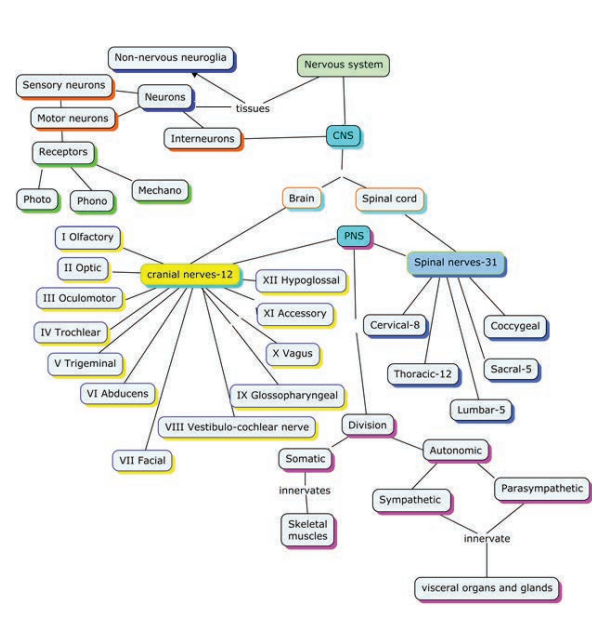Reflex Action and Reflex Arc
When dust falls in our eyes, the eyelids close immediately not waiting for our willingness; on touching a hot pan, the hand is withdrawn rapidly. Do you know how this happens?
The spinal cord remains as a connecting functional nervous structure in between the brain and effector organs. But sometimes when a very quick response is needed, the spinal cord can effect motor initiation as the brain and brings about an effect. This rapid action by spinal cord is called reflex action. It is a fast, involuntary, unplanned sequence of actions that occurs in response to a particular stimulus. The nervous elements involved in carrying out the reflex action constitute a reflex arc or in other words the pathway followed by a nerve impulse to produce a reflex action is called a reflex arc (Figure 10.12).
Functional Components of a Reflex Arc
Sensory Receptor - It is a sensory structure that responds to a specific stimulus.
Sensory Neuron - This neuron takes the sensory impulse to the grey (afferent) matter of the spinal cord through the dorsal root of the spinal cord.
Interneurons - One or two interneurons may serve to transmit the impulses from the sensory neuron to the motor neuron.
Motor Neuron - it transmits impulse from CNS to the effector organ.
Effector Organs - It may be a muscle or gland which responds to the impulse received. There are two types of reflexes. They are
-
Unconditional reflex is an inborn reflex for an unconditioned stimulus. It does not need any past experience, knowledge or training to occur; Ex: blinking of an eye when a dust particle about to fall into it, sneezing and coughing due to foreign particle entering the nose or larynx.
-
Conditioned reflex is a respone to a stimulus that has been acquired by learning. This does not naturally exists in animals. Only an experience makes it a part of the behaviour. Example: excitement of salivary gland on seeing and smelling a food. The conditioned reflex was first demonstrated by the Russian physiologist Pavlov in his classical conditioning experiment in a dog. The cerebral cortex controls the conditioned reflex.
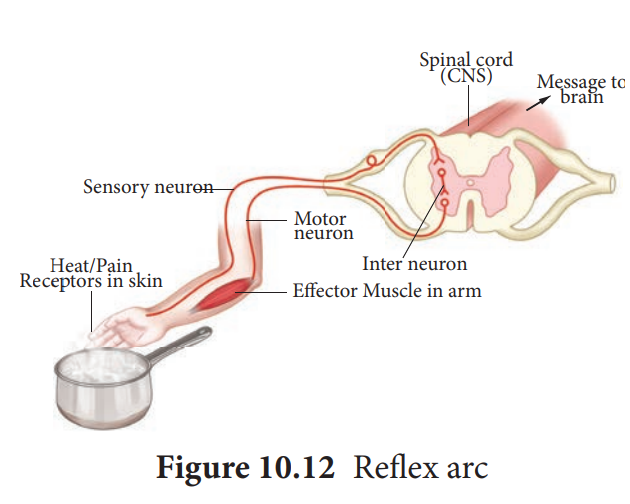
Peripheral Neural System (PNS) PNS consists of all nervous tissue outside the CNS. Components of PNS include nerves, ganglia, enteric plexuses and sensory receptors. A nerve is a chord like structure that encloses several neurons inside. Ganglia (singular- ganglion) are small masses of nervous tissue, consisting primarily of neuron cell bodies and are located outside the brain and spinal cord. Enteric plexuses are extensive networks of neurons located in the walls of organs of the gastrointestinal tract. The neurons of these plexuses help in regulating the digestive system. The specialized structure that helps to respond to changes in the environment i.e. stimuli are called sensory receptor which triggers nerve impulses along the afferent fibres to CNS. PNS comprises of cranial nerves arising from the brain and spinal nerves arising from the spinal cord.
(A) Cranial Nerves: There are 12 pairs of cranial nerves, of which the first two pairs arise from the fore brain and the remaining 10 pairs from the mid brain. Other than the Vagus nerve, which extends into the abdomen, all cranial nerves serve the head and face.
(B) Spinal Nerves: 31 pairs of spinal nerves emerge out from the spinal cord through spaces called the intervertebral foramina found between the adjacent vertebrae. The spinal nerves are named according to the region of vertebral column from which they originate
i. Cervical nerves (8 pairs) ii. Thoracic nerves (12 pairs) iii. Lumbar nerves (5 pairs) iv. Sacral nerves (5 pairs) v. Coccygeal nerves (1 pair)
Each spinal nerve is a mixed nerve containing both afferent (sensory) and efferent (motor) fibres. It originates as two roots:1) a posterior dorsal root with a ganglion outside the spinal cord and 2) an anterior ventral root with no external ganglion.
Somatic Neural System (SNS) The somatic neural system (SNS or voluntary neural system) is the part of the peripheral neural system associated with the voluntary control of body movements via skeletal muscles. The sensory and motor nerves that innervate striated muscles form the somatic neural system. Major functions of the somatic neural system include voluntary movement of the muscles and organs, and reflex movements.
In adult, the total CSF volume is about 150 ml and is replaced every 8 hours. About 500 ml of CSF is formed daily. The choroid plexus helps cleanse the CSF by removing waste products.
Autonomic Neural System The autonomic neural system is auto functioning and self governed. It is a part of peripheral neural system that innervates smooth muscles, glands and cardiac muscle. This system controls and coordinates the involuntary activities of various organs. ANS controlling centre is in the hypothalamus.
Autonomic neural system comprises the following components:
Preganglionic neuron whose cell body is in the brain or spinal cord; its myelinated axon exits the CNS as part of cranial or spinal nerve and ends in an autonomic ganglion.
Autonomic ganglion consists of axon of preganglionic neuron and cell bodies of postganglionic neuron.
Postganglionic neuron conveys nerve impulses from autonomic ganglia to visceral effector organs.
The autonomic neural system consists of Sympathetic neural system and Parasympathetic neural system.
Your friend is returning home after his visit to USA. All at home are waiting for his arrival. How would you feel? State the division of ANS that predominates and mention few changes that take place in your body.
Sensory Reception and Processing
Our senses make us aware of changes that occur in our surroundings and also within our body. Sensation [awareness of the stimulus] and perception [interpretation of the meaning of the stimulus] occur in the brain.
Receptors are classified based on their location: 1. Exteroceptors are located at or near the surface of the body. These are sensitive to external stimuli and receive sensory inputs for hearing, vision, touch, taste and smell. 2. Interoceptors are located in the visceral organs and blood vessels. They are sensitive to internal stimuli. Proprioceptors are also a kind of interoceptors. They provide information about position and movements
Table 10.3 Types of receptors
| Receptors | Stimulus | Effector organs |
|---|---|---|
| Mechanoreceptors | Pressure and vibration | Mechano receptors are present in the cochlea of the inner ear and the semi circular canal and utriculus |
| Chemoreceptors | Chemicals | Taste buds in the tongue and nasal epithelium |
| Thermoreceptors | Temperature | Skin |
| Photoreceptors | Light | Rod and cone cells of the retina in the eye |
of the body. These are located in the skeletal muscles, tendons, joints, ligaments and in connective tissue coverings of bones and muscles. Receptors based on the type of stimulus are shown in Table 10.3.
Photoreceptor - Eye
Eye is the organ of vision; located in the orbit of the skull and held in its position with the help of six extrinsic muscles. They are superior, inferior, lateral, median rectus muscles, superior oblique and inferior oblique muscles. These muscles aid in the movement of the eyes and they receive their nerve innervation from III, IV and VI cranial nerves. Eyelids, eye lashes and eye brows are the accessory structures useful in protecting the eyes. The eye lids protect the eyes from excessive light and foreign objects and spread lubricating secretions over the eyeballs.
Eyelashes and the eyebrows help to protect the eyeballs from foreign objects, perspiration and also from the direct rays of sunlight. Sebaceous glands at the base of the eyelashes are called ciliary glands which secrete a lubricating fluid into the hair follicles. Lacrymal glands, located in the upper lateral region of each orbit, secrete tears. Tears are secreted at the rate of 1mL/day and it contains salts, mucus and lysozyme enzyme to destroy bacteria.The conjunctiva is a thin, protective mucous membrane found lining the outer surface of the eyeball (Figure 10.13).
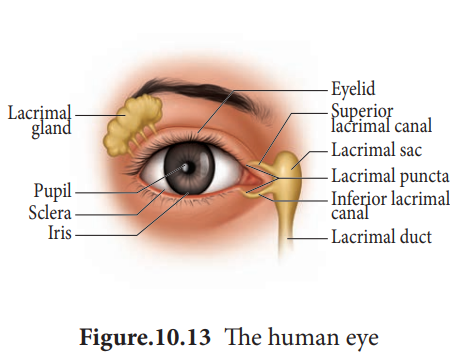
The eye has two compartments, the anterior and posterior compartments. The anterior compartment has two chambers, first one lies between the cornea and iris and the second one lies between the iris and lens. These two chambers are filled with watery fluid called aqueous humor. The posterior compartment lies between the lens and retina and it is filled with a jelly like fluid called vitreous humor that helps to retain the spherical nature of the eye. Eye lens is transparent and biconvex, made up of long columnar epithelial cells called lens fibres. These cells are accumulated with the proteins called crystalline.
The Eye Ball The eye ball is spherical in nature. The anterior one- sixth of the eyeball is exposed; the remaining region is fitted well into the orbit. The wall of the eye ball consists of three layers: fibrous Sclera, vascular Choroid and sensory Retina (Figure 10.14).
The outer coat is composed of dense non-vascular connective tissue. It has two regions: the anterior cornea and the posterior sclera. Cornea is a non-vascular transparent coat formed of stratified squamous epithelium which helps the cornea to renew continuously as it is very vulnerable to damage from dust. Sclera forms the white of the eye and protects the eyeball. Posteriorly the sclera is innervated by the optic nerve. At the junction of the sclera and the cornea, is a channel called ‘canal of schlemm’ which continuously drains out the excess of aqueous humor.
DO YOU KNOW ? Dilation and congestion of the blood vessels of the conjunctiva due to local irritation or infection are the cause of bloodshoteye (conjunctivitis - commonly called Madras eye). Infection of ciliary glands by bacteria causes a painful, pus filled swelling called a Sty.
The cornea is the only tissue in the body that can be transplanted from one person to another with little or no possibility of rejection. This is because cornea does not have blood vessels.
Choroid is highly vascularized pigmented layer that nourishes all the eye layers and its pigments absorb light to prevent internal reflection. Anteriorly the choroid thickens to form the ciliary body and iris. Iris is the coloured portion of the eye lying between the cornea and lens. The aperture at the centre of the iris is the pupil through which the light enters the inner chamber. Iris is made of two types of muscles the dilator papillae (the radial muscle) and the sphincter papillae (the circular muscle).In the bright light, the circular muscle in the iris contract; so that the size of pupil decreases and less light enters the eye. In dim light, the radial muscle in the iris contract; so that the pupil size increases and more light enters the eye. Smooth muscle present in the ciliary body is called the ciliary muscle which alters the convexity of the lens for near and far vision. The ability of the eyes to focus objects at varying distances is called accommodation which is achieved by
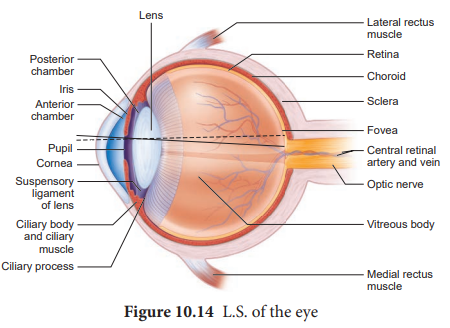
Retina forms the inner most layer of the eye and it contains two regions: A sheet of pigmented epithelium (non visual part) and neural visual regions. The neural retina layer contains three types of cells: photoreceptor cells – cones and rods (Figure 10.15 and Table 10.4), bipolar cells and ganglion cells.
Table 10.4 Differences between rod and cone Rod cells
| Rod cells | C one cells |
|---|---|
| Rods are responsible for vision in dim light | The cones are responsible for colour vision and works best in the bright light. |
| The pigment present in the rods is rhodopsin, formed of a protein scotopsin and retinal (an aldehyde of vitamin A ) | The pigment present in the cones is photopsin, formed of opsin protein and retinal. |
| There are about 120 millions rod cells | There may be 6-7 millions cone cells |
| Rods are predominant in the extra fovea region | Cones are concentrated in the fovea region |
suspensory ligament, ciliary muscle and ciliary body. The suspensory ligament extends from the ciliary body and helps to hold the lens in its upright position. The ciliary body is provided with blood capillaries that secrete a watery fluid called aqueous humor that fills the anterior chamber.
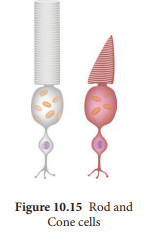
The yellow flat spot at the centre of the posterior region of the retina is called macula lutea which is responsible for sharp detailed vision. A small depression present in the centre of the yellow spot is called fovea centralis which contains only cones. The optic nerves and the retinal blood vessels enter the eye slightly below the posterior pole, which is devoid of photo receptors; hence this region is called blind spot.
Mechanism of Vision When light enters the eyes, it gets refracted by the cornea, aqueous humor and lens and it is focused on the retina and excites the rod and cone cells. The photo pigment consists of Opsin, the protein part and Retinal, a derivative of vitamin A. Light induces dissociation of retinal from opsin and causes the structural changes in opsin. This generates an action potential in the photoreceptor cells and is transmitted by the optic nerves to the visual cortex of the brain, via bipolar cells, ganglia and optic nerves, for the perception of vision.
Refractive errors of eye Myopia (near sightedness): The affected person can see the nearby objects but not the distant objects. This condition may result due to an elongated eyeball or thickened lens; so that the image of distant object is formed in front of the yellow spot. This error can be corrected using concave lens that diverge the entering light rays and focuses it on the retina.
H y p e r m e t r o p i a (long sightedness): the affected person can see only the distant objects clearly but not the objects nearby. This condition results due to a shortened eyeball and thin lens; so the image of closest object is converged behind the retina. This defect can be overcome by using convex lens that converge the entering light rays on the retina.
Presbyopia: Due to aging, the lens loses elasticity and the power of accommodation. Convex lenses are used to correct this defect.
Astigmatism is due to the rough (irregular) curvature of cornea or lens. Cylindrical glasses are used to correct this error (Figure 10.16).
Cataract: Due to the changes in nature of protein, the lens becomes opaque. It can be corrected by surgical procedures.
Visual pigments for colour vision are i) the red cones having the visual pigment, Erythropsin is sensitive to long wavelength close to 560 nm. ii) The green cones having the pigment, chloropsin is sensitive to medium wavelength of 530 nm iii) the blue cones having the pigment, cyanopsin is sensitive to short wavelength of 420 nm.
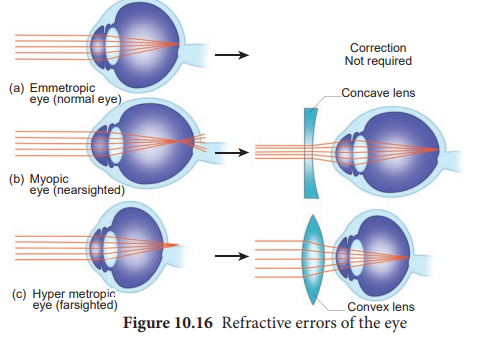
Aqueous humour supplies nutrients and oxygen to the lens, cornea and some retinal cells. The aqueous humor is produced and drained at the same rate, maintaining a constant intra ocular pressure of about 16 mmHg. Any block in the canal of schlemm increases the intra-ocular pressure of aqueous humor and leads to ‘Glaucoma’ where the optic nerve and the retina are compressed due to pressure.
Phonoreceptor
The ear is the site of reception of two senses namely hearing and equilibrium. Anatomically, the ear is divided into three regions: the external ear, the middle ear and internal ear.
The external ear consists of pinna, external auditory meatus and ear drum. The pinna is flap of elastic cartilage covered by skin. It collects the sound waves. The external auditory meatus is a curved tube that extends up to the tympanic membrane [the ear drum]. The tympanic membrane is composed of

connective tissues covered with skin outside and with mucus membrane inside.
There are very fine hairs and wax producing sebaceous glands called ceruminous glands in the external auditory meatus. The combination of hair and the ear wax [cerumen] helps in preventing dust and foreign particles from entering the ear.
The middle ear is a small air-filled cavity in the temporal bone. It is separated from the external ear by the eardrum and from the internal ear by a thin bony partition; the bony partition contains two small membrane covered openings called the oval window and the round window.
The middle ear contains three ossicles: malleus [hammer bone], incus [anvil bone] and stapes [stirrup bone] which are attached to one another. The malleus is attached to the tympanic membrane and its head articulates with the incus which is the intermediate bone lying between the malleus and stapes. The stapes is attached to the oval window in the inner ear. The ear ossicles transmit sound waves to the inner ear. A tube called Eustachian tube connects the middle ear cavity with the pharynx. This tube helps in equalizing the pressure of air on either sides of the ear drum.
Inner ear is the fluid filled cavity consisting of two parts, the bony labyrinth and the membranous labyrinths. The bony labyrinth consists of three areas: cochlea, vestibule and semicircular canals. The cochlea is a coiled portion consisting of 3 chambers namely: scala vestibuli and scala tympani- these two are filled with perilymph; and the scala media is filled with endolymph. At the base of the cochlea, the scala vestibule ends at the ‘oval window’ whereas the scala tympani ends at the ‘round window’ of the middle ear. The chambers scala vestibuli and scala media are separated by a membrane called Reisner’s membrane whereas the scala media and scala tympani are separated by a membrane called Basilar membrane (Figure 10.17)
Organ of Corti The organ of Corti (Figure.10.18) is a sensory ridge located on the top of the Basilar membrane and it contains numerous hair cells that are arranged in four rows along the length of the basilar membrane. Protruding from the apical part of each hair cell is hair like structures known as stereocilia. During the conduction of sound wave, stereocilia makes a contact with the stiff gel membrane called tectorial membrane, a roof like structure overhanging the organ of corti throughout its length.
Mechanism of hearing Sound waves entering the external auditory meatus fall on the tympanic membrane. This causes the ear drum to vibrate, and these vibrations are transmitted to the oval window through the three auditory ossicles. Since the tympanic membrane is 17-20 times larger than the oval window, the pressure exerted on the oval window is about 20 times more than that on the tympanic membrane. This increased pressure generates pressure waves in the fluid of perilymph. This pressure causes the round window to alternately bulge outward and inward meanwhile the basilar membrane along with the organ of Corti move up and down. These movements of the hair alternately open and close the mechanically gated ion channels in the base of hair cells and the action potential is propagated to the brain as sound sensation through cochlear nerve.
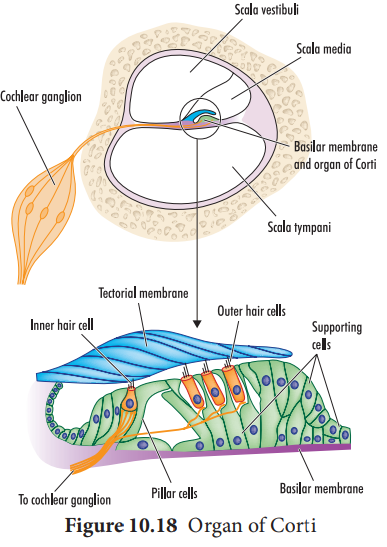
Defects of Ear Deafness may be temporary or permanent. It can be further classified into conductive deafness and sensory-neural deafness. Possible causes for conductive deafness may be due to
- the blockage of ear canal with earwax,
- Rupture of eardrum
- Middle ear infection with fluid accumulation
- Restriction of ossicular movement. In sensory-neural deafness, the defect may be in the organ of Corti or the auditory nerve or in the ascending auditory pathways or auditory cortex.
Organ of Equilibrium Balance is part of a sense called proprioception, which is the ability to sense the position, orientation and movement of the body. The organ of balance is known as the vestibular system which is located in the inner ear next to the cochlea. The vestibular system is composed of a series of fluid filled sacs and tubules.These sacs and tubules contain endolymph and are kept in the surrounding perilymph (Figure 10.19). These two fluids, perilymph and endolymph, respond to the mechanical forces, during changes occurring in body position and acceleration.

Name the parts of the organ of equilibrium involved in the following functions. a) Linear movement of the body b) Changes in the body position c) Rotational movement of the head.
The utricle and saccule are two membranous sacs, found nearest the cochlea and contain equilibrium receptor regions called maculae that are involved in detecting the linear movement of the head. The maculae contain the hair cells that act as mechanorecptors. These hair cells are embeded in a gelatinous otolithic membrane that contains small calcareous particles called otoliths. This membrane adds weight to the top of the hair cells and increase the inertia.
The canals that lie posterior and lateral to the vestibule are semicircular canals; they are anterior, posterior and lateral canals oriented at right angles to each other**.** At one end of each semicircular canal, at its lower end has a swollen area called ampulla. Each ampulla has a sensory area known as crista ampullaris which is formed of sensory hair cells and supporting cells. The function of these canals is to detect rotational movement of the head.
The intensity of sound is measured in decibels (dB). 0 dB is the threshold of hearing for normal ear. Severe hearing loss occurs with frequent or prolonged exposure to sound with intensities greater than 90dB. For meaningful conversations the intensity should be in the 50 dB range.
Olfactory Receptors
The receptors for taste and smell are the chemoreceptors. The smell receptors are excited by air borne chemicals that dissolve in fluids. The yellow coloured patches of olfactory epithelium form the olfactory organs that are located on the roof of the nasal cavity. The olfactory epithelium is covered by a thin coat of mucus layer below and olfactory glands bounded connective tissues, above. It contains three types of cells: supporting cells, Basal cells and millions of pin shaped olfactory receptor cells(which are unusual bipolar cells). The olfactory glands and the supporting cells secrete the mucus. The unmyelinated axons of the olfactory receptor cells are gathered to form the filaments of olfactory nerve [cranial nerve I] which synapse with cells of olfactory bulb. The impulse, through the olfactory nerves, is transmitted to the frontal
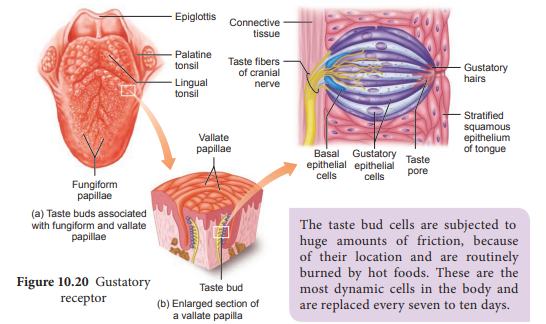
lobe of the brain for identification of smell and the limbic system for the emotional responses to odour. Gustatory receptor: The sense of taste is considered to be the most pleasurable of all senses. The tongue is provided with many small projections called papillae which give the tongue an abrasive feel. Taste buds are located mainly on the papillae which are scattered
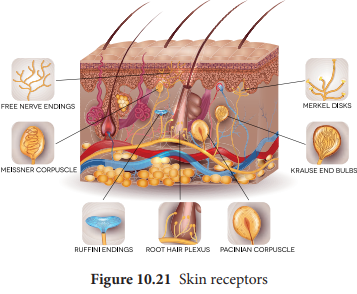
over the entire tongue surface. Most taste buds are seen on the tongue (Figure 10.20) few are scattered on the soft palate, inner surface of the cheeks, pharynx and epiglottis of the larynx. Taste buds are flask-shaped and consist of 50 – 100 epithelial cells of two major types. Gustatory epithelial cells (taste cells) and Basal epithelial cells (Repairing cells**)** Long microvilli called gustatory hairs project from the tip of the gustatory cells and extends through a taste pore to the surface of the epithelium where they are bathed by saliva. Gustatory hairs are the sensitive portion of the gustatory cells and they have sensory dendrites which send the signal to the brain. The basal cells that act as stem cells, divide and differentiate into new gustatory cells (Figure 10.20).
Skin-Sense of touch Skin is the sensory organ of touch and is also the largest sense organ. This sensation comes from millions of microscopic sensory receptors located all over the skin and associated with the general sensations of contact, pressure, heat, cold and pain. Some parts of the body, such as the finger tips have a large number of these receptors, making them more sensitive. Some of the sensory receptors present in the skin (Figure 10.21) are:
-
Tactile merkel disc is light touch receptor lying in the deeper layer of epidermis.
-
Hair follicle receptors are light touch receptors lying around the hair follicles.
-
Meissner’s corpuscles are small light pressure receptors found just beneath the epidermis in the dermal papillae. They are numerous in hairless skin areas such as finger tips and soles of the feet.
-
Pacinian corpuscles are the large egg shaped receptors found scattered deep in the dermis and monitoring vibration due to pressure. It allows to detect different textures, temperature, hardness and pain
-
Ruffini endings which lie in the dermis responds to continuous pressure.
-
Krause end bulbs are thermoreceptors that sense temperature.
Melanocytes are the cells responsible for producing the skin pigment, melanin, which gives skin its colour and protects it from the sun’s UV rays. Vitiligo (Leucoderma) is a condition in which the melanin pigment is lost from areas of the skin, causing white patches, often with no clear cause. Vitiligo is not contagious. It can affect people of any age, gender, or ethnic group. The patches appear when melanocytes fails to synthesis melanin pigment.
Summary
Neural system coordinates and integrates the functions of all organs and responds to changes in the internal and external environments.
Neural system includes two types of cells neurons and neuroglia. Neuron forms the structural and functional unit of the neural system.
CNS includes brain and spinal cord. The major parts of the brain are the cerebrum, diencephalon, cerebellum and the brain stem. The brain is protected by the cranium and meninges. CSF provides mechanical protection and nutrients to the CNS.
The spinal cord is the continuation of the medulla oblongata and ends at the second lumbar vertebra as conus medullaris. The components involved in reflex action are called reflex arc.
There are 12 pairs of cranial nerves which arise from the brain and 31 pairs of spinal nerves from the spinal cord make the PNS. The PNS is further divided into Somatic Neural system and Autonomic Neural system. The SNS operates under conscious control. The ANS usually operates unconsciously.
The motor portion of ANS has two major divisions: sympathetic and parasympathetic.
Sensation is the conscious or subconscious awareness of changes in the external or internal environment. Four events namely stimulation, transduction, generation of impulses and integration occurs typically for a sensation to take place.
Simple receptors are associated with the general senses such as somatic senses (skin); complex receptors are associated with the special senses such as smell, taste, vision, hearing and equilibrium.
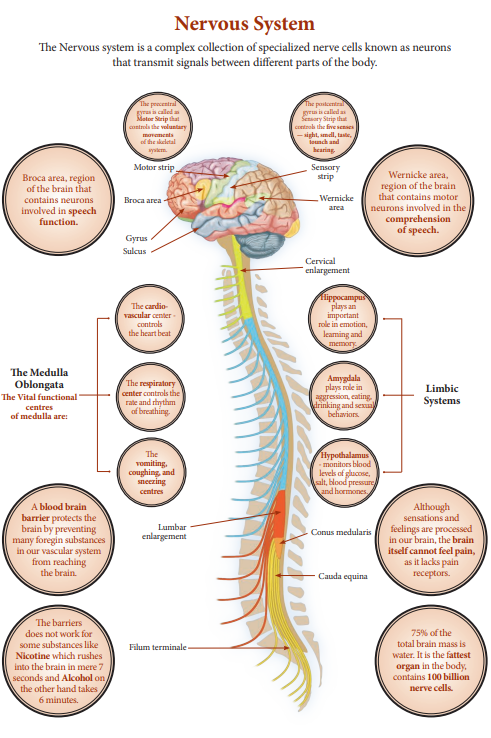
Evaluation
-
Which structure in the ear converts pressure waves to action potentials? a. Tympanic membrane b. Organ of Corti c. Oval window d. Semicircular canal
-
Which of the following pairings is correct? a. Sensory nerve– afferent b. Motor nerve - afferent c. Sensory nerve – ventral d. Motor nerve – dorsal
-
During synaptic transmission of nerve impulse, neurotransmitter (P) is released from synaptic vesicles by the action of ions (Q). Choose the correct P and Q. a. P = Acetylcholine, Q = Ca++ b. P = Acetylcholine, Q = Na+ c. P = GABA, Q=Na+ d. P = Cholinesterase, Q = Ca++
-
Examine the diagram of the two cell types A and B given below and select the correct option. a. Cell-A is the rod cell found evenly all over retina b. Cell-A is the cone cell more concentrated in the fovea centralis c. Cell-B is concerned with colour vision in bright light d. Cell-A is sensitive to bright light intensities
-
Assertion: The imbalance in concentration of Na+, K+ and proteins generates action potential.
Reason: To maintain the unequal distribution of Na+ and K+, the neurons use electrical energy. a. Both Assertion and Reason are true and Reason is the correct explanation of the Assertion. b. Both Assertion and Reason are true but the Reason is not the correct explanations of Assertion. c. Assertion is true, but Reason is false. d. Both Assertion and Reason are false. -
Which part of the human brain is concerned with the regulation of body temperature? a. Cerebellum b. Cerebrum c. Medulla oblongata d. Hypothalamus
-
The respiratory centre is present in the a. Medulla oblongata b. Hypothalamus c. Cerebellum d. Thalamus
-
Match the following human spinal nerves in column I with their respective number in column II and choose the correct option
| co lumn I | co lumn II |
|---|---|
| P. C er v ic a l n er ves | i. 5 p air s |
| Q. Th oracic n er ve | ii . 1 p air |
| R . L um b ar n er ve | iii . 12 p air |
| S. C o cc yg e a l n er ve | iv. 8 p air |
a. ( P-iv ),( Q-iii ),( R-i ),( S-ii ) b. ( P-iii ), ( Q-i ), ( R-ii ), ( S-iv ) c. ( P-iv ),( Q-i ),( R-ii ),( S-iii ) d. ( P-ii ), ( Q-iv ), ( R-i ), ( S-iii )
-
The abundant intracellular cation is a. H+ b. K+ c. Na+ d. Ca++
-
Which of the following statements is wrong regarding conduction of nerve impulse? a. In a resting neuron, the axonal membrane is more permeable to K+ ions and nearly impermeable to Na+ ions. b. Fluid outside the axon has a high concentration of Na+ ions and low concentration of K+, in a resting neuron. c. Ionic gradient s are maintained by Na+ K+ pumps across the resting membrane, which transport 3Na ions outwards for 2K+ into the cell. d. A neuron is polarized only when the outer surface of the axonal membrane possess a negative a charge and its inner surface is positively charged.
-
All of the following are associated with the myeline sheath except a. Faster conduction of nerve impulses b. Nodes of Ranvier forming gaps along the axon c. Increased energy output for nerve impulse conduction d. Saltatory conduction of action potential
-
Several statements are given here in reference to cone cells which of the following option indicates all correct statements for cone cells ? Statements (i) Cone cells are less sensitive in bright light than Rod cells (ii) They are responsible for colour vision (iii) Erythropsin is a photo pigment which is sensitive to red colour light
(iv) They are present in fovea of retina a. (iii), (ii) and (i) b. (ii) , (iii) and (iv) c. (i), (iii) and (iv) d. (i), (ii) and (iv) -
Which of the following statement concerning the somatic division of the peripheral neural system is incorrect? a. Its pathways innervate skeletal muscles b. Its pathways are usually voluntary c. Some of its pathways are referred to as reflex arcs d. Its pathways always involve four neurons
-
When the potential across the axon membrane is more negative than the normal resting potential, the neuron is said to be in a state of a. Depolarization b. Hyperpolarization c. Repolarization d. Hypopolarization
-
Why is the blind spot called so?
-
Sam’s optometrist tells him that his intraocular pressure is high. What is this condition called and which fluid does it involve?
-
The action potential occurs in response to a threshold stimulus; but not at sub threshold stimuli. What is the name of the principle involved?
-
Pleasant smell of food urged Ravi to rush into the kitchen. Name the parts of the brain involved in the identification of food and emotional responses to odour.
-
Cornea transplant in humans is almost never rejected. State the reason.
-
At the end of repolarization, the nerve membrane gets hyperpolarized. Why?
-
The choroid plexus secretes cerebrospinal fluid. List the function of it.
-
What is ANS? Explain the components of ANS.
-
Why the limbic system is called the emotional brain? Name the parts of it.
-
Classify receptors based on type of stimuli.
-
Differentiate between rod and cone cells.
-
The sense of taste is considered to be the most pleasurable of all senses. Describe the structure of the receptor involved with a diagram.
-
Describe the sensory receptors present in the skin.
Concept Map
